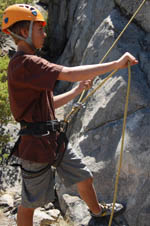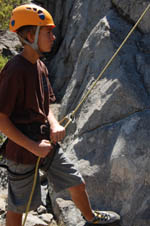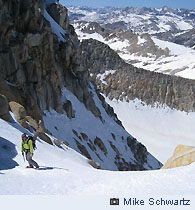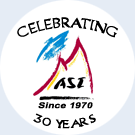 |
|
Upcoming Programs
Conditions Updates
Tech Tips |
 |

Mimi Vadasz
Adminstrative Director
AMGA Certified
Ski Mountaineering Guide

Bela G. Vadasz
Technical Director
IFMGA Certified Guide
|

May 21, 2009
Friends of ASI
True to form, despite the gloomy perspective of naysayers, core alpinists like you know that the skiing is still rockin', even as the rock season beckons. Senior Guide Peter Leh reported that the recent trip to Hidden Valley on Mt. Shasta delivered 6,000 vert of Shasta suprêmo corn on the huge skiing canvas of the West Face. So, while it may be ending, ski season is closing on a strong note, as epitomized by Scott Gailey, who told us, "The [Sierra High Route] was awesome. What a great first year of AT skiing, thanks to ASI!"
Hearing feedback like that is why we're still turning people on to mountains and the spirit of the alpinist.
With the conditions still good, we want to invite you to join us for a ski season finalé at Tioga Pass. The road is open to the park entrance from the east, and should be open from the west by the end of May, exactly when we will be there.
Every persuasion of backcountry skier is invited, rando', tele', and splitters are all welcome. After making some exciting tracks on Saturday we'll celebrate the season with a Bar BQ and beer.
Now that rock season is upon us, we thought a tech tip of a basic skill (see below) was in order. Yeah, you already know how to belay, so this is more to let you know this tech tip will be up on our website as a point of reference for friends who don't know how but want to start climbing rock, especially if they want to know how you protect yourself when you inevitably fall.

The 4-Step Belay - Better than 3
By Bela G. Vadasz
The art of belaying is the cornerstone of safe climbing-the security upon which a climber's skill hangs in the balance. It is commonly assumed that everyone understands the criteria for proper belaying but the history of climbing accidents indicates this is often a false assumption. Thus, it is worthwhile to review this most basic climbing procedure.
The currently accepted method for implementing a top roped belay consists of four distinct steps for maximizing security with a mechanical belay device. For those who have been climbing for a long time, please note, this is slightly different from a 3-step system taught several decades ago.
Good top rope, bottom-belaying begins with a solid stance, well braced against the direction of pull, toward the top anchor. In some cases, anchoring the belayer may be recommended depending on factors that could overpower the belayer such as: weight difference between the climber and belayer, the steepness of the climb, the amount of friction of the rope running over rock or, the angle of climbing from side to side that might cause a climber to pendulum and increase the load.
The 4-Step belaying method dramatically reduces the time the belay rope is not in the locked position against the belay device. Here are the four steps:
Step 1:
Use both hands, one pulling, the other pushing, to move the slack rope through the belay device.
 
Step 2:
Quickly redirect the brake strand against the belay device to lock it off.

Step 3:
Use your hand from the climber strand and grab the brake strand just below the belay device, keeping it locked off.

Step 4:
Slide your brake hand up the brake strand and move your upper hand back to the climber strand.
 
Now you're ready to cycle through the four steps again as needed in relation to the speed and progress of the climber.
This is the most secure method of top-rope, bottom-belaying with a traditional belay device.

Caution: It is recommended to practice these techniques under the coaching and supervision of a qualified instructor. ASI makes no guarantees regarding the use of techniques illustrated or recommended on this website with regard to insuring personal safety or preventing injury or death.

We look forward to skiing with you and helping you achieve your goals. If you can't find the answer to a question on our website, don't hesitate to give us a call.
Sincerely,
Bela & Mimi Vadasz
Directors
Alpine Skills International
530-582-9170


|
|


|
